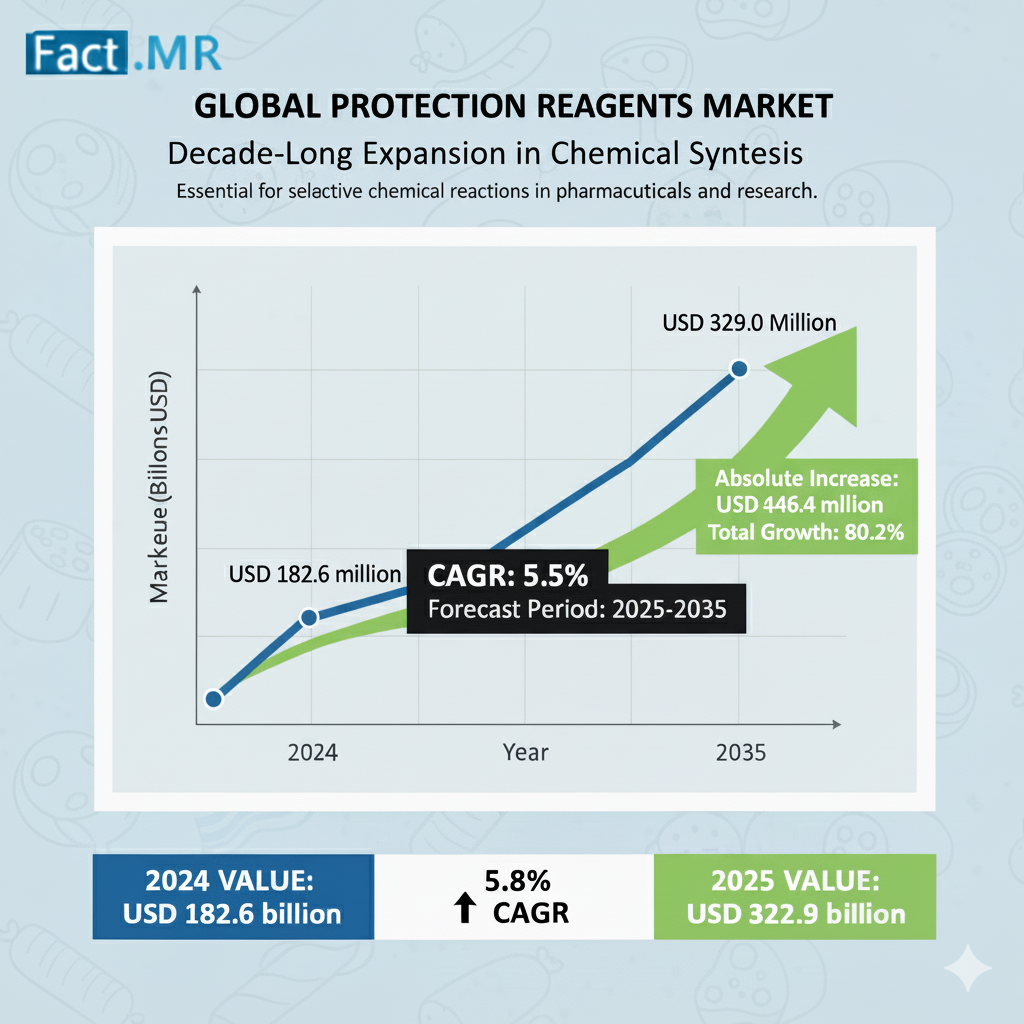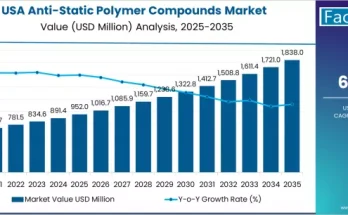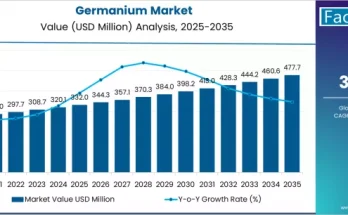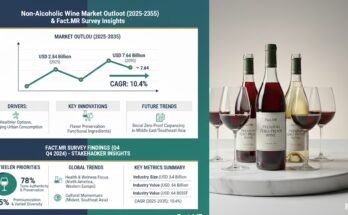Fact.MR Report Highlights Steady 5.5% CAGR Growth as Industry Leaders Strengthen Investments in High-Purity Chemical Synthesis Tools The global protection reagents market was valued at US$ 182.6 Million in 2024 and has been forecasted to expand at a noteworthy CAGR of 5.5% to end up at US$ 329.0 Million by 2035.a leading provider of market research and competitive intelligence. This upward trajectory underscores the growing importance of chemical compounds used to safeguard functional groups in organic synthesis—an essential process for achieving precision, purity, and efficiency in pharmaceuticals, biotechnology, and advanced research.
Protection reagents, crucial in controlling reactivity during multi-step synthesis, have become indispensable tools across R&D laboratories and industrial-scale production. Their ability to maintain molecular integrity in complex chemical reactions is increasingly valued amid the accelerating pace of drug discovery, biopharmaceutical innovation, and green chemistry advancements.
Rising Pharmaceutical R&D Investments Bolster Market Momentum:
One of the key growth drivers identified in the report is the surge in pharmaceutical research and development, particularly in oncology, rare diseases, and personalized medicine. As pharmaceutical companies intensify efforts to develop complex molecular structures and next-generation biologics, demand for high-performance protection reagents continues to escalate.
Fact.MR highlights that short-term growth (2024–2028) will be heavily influenced by the pharmaceutical sector’s investment in novel drug discovery pipelines, which rely on effective protection strategies to enhance yield and minimize impurities. In the medium term (2028–2030), the expansion of biopharmaceutical development—especially recombinant proteins and monoclonal antibodies—is expected to further amplify reagent adoption.
Looking to the long term (2030–2035), integration of automation and artificial intelligence (AI) in chemical synthesis will reshape laboratory workflows, boosting the demand for efficient, automated-compatible protection reagents. High-throughput and AI-driven synthesis systems are expected to open new frontiers for reagent applications in both industrial chemistry and drug development.
Technological Progress and Strategic Collaborations Redefining Market Dynamics:
Recent strategic alliances among global leaders are fostering a wave of innovation in the protection reagents ecosystem. For instance, in August 2023, Agilent Technologies strengthened its partnership with Element Biosciences to enhance genome sequencing and analysis workflows, expanding the reach of Agilent’s SureSelect target enrichment panels. This collaboration exemplifies how major players are leveraging partnerships to integrate reagents with cutting-edge genomic tools.
Similarly, in May 2024, Merck KGaA announced its USD 600 million acquisition of Mirus Bio, a key developer of RNA delivery and gene editing technologies. This move is set to enhance Merck’s life sciences portfolio, particularly in developing innovative protection reagents designed for complex molecular synthesis and next-generation therapeutics.
Regional Insights: North America Leads, China Emerges as Growth Engine:
North America, led by the United States, remains the largest regional market, accounting for 31.5% of global market share in 2025. The U.S. market alone is forecasted to expand at a CAGR of 6.1%, reaching USD 43.9 million in 2025 and generating USD 35.5 million in absolute growth by 2035. The country’s dominance is attributed to its robust pharmaceutical and biotechnology infrastructure, strong academic research base, and stringent regulatory standards promoting high-quality chemical manufacturing.
Conversely, China represents the fastest-growing market, projected to achieve a 7.1% CAGR and reach USD 42.4 million by 2035. Driven by rapidly expanding pharmaceutical and biotech industries, rising R&D investments, and government-backed innovation policies, China is quickly emerging as a strategic hub for reagent manufacturers. Global and domestic players are increasingly targeting the Chinese market to capitalize on its surging demand for advanced synthetic chemistry solutions.
Product and Application Trends: Benzyl Protecting Groups Lead the Way:
By product type, benzyl protecting groups dominate the global market and are expected to grow at a CAGR of 5.8% through 2035. Their widespread use stems from their stability under diverse reaction conditions and ease of removal under mild processing, making them ideal for pharmaceutical and organic synthesis applications.
From an application standpoint, pharmaceutical synthesis remains the largest end-use sector, followed by biotechnology and academic research. Within the end-user landscape, pharmaceutical companies and biotechnology firms represent the most prominent consumers, while contract research organizations (CROs) are rapidly adopting advanced reagents to improve turnaround times and reaction efficiency.
Market Challenges: Navigating Regulatory and Sustainability Barriers:
Despite its promising growth outlook, the protection reagents industry faces stringent regulatory and environmental compliance challenges. Manufacturers must adhere to global standards governing chemical safety, waste management, and sustainable production, compelling them to invest heavily in R&D and eco-friendly manufacturing techniques.
The report emphasizes that while these challenges increase operational costs, they also encourage innovation in green chemistry—a trend likely to define the next generation of reagent production. Companies that successfully balance compliance with sustainability will be well-positioned to capture long-term market value.
Competitive Landscape: Innovation and Customization at the Core:
Key players shaping the protection reagents market include:
Agilent Technologies, Avantor, Bachem, Bio-Rad Laboratories, Genscript, Merck KGaA, Roche, Santa Cruz Biotechnology, TCI Chemicals, and Thermo Fisher Scientific.
These companies are heavily investing in product customization, collaborative R&D, and technological advancements to expand their global footprint. Fact.MR notes that major players are focusing on tailored solutions for pharmaceutical and biotech clients, ensuring alignment with evolving regulatory and sustainability goals.
Future Outlook: A Decade of Opportunity and Innovation:
According to Fact.MR’s comprehensive forecast, the protection reagents market’s journey toward USD 329 million by 2035 will be shaped by:
– Continued pharmaceutical innovation and biologics expansion
– Integration of AI and automation in chemical synthesis
– Demand for greener, more efficient protection strategies
– Global collaborations among life sciences leaders
As industries increasingly rely on complex chemical synthesis for novel therapies, diagnostics, and biomolecular engineering, protection reagents will remain at the heart of this transformation—enabling precision, purity, and progress in modern chemistry.
Browse Full Report-https://www.factmr.com/report/protection-reagents-market



